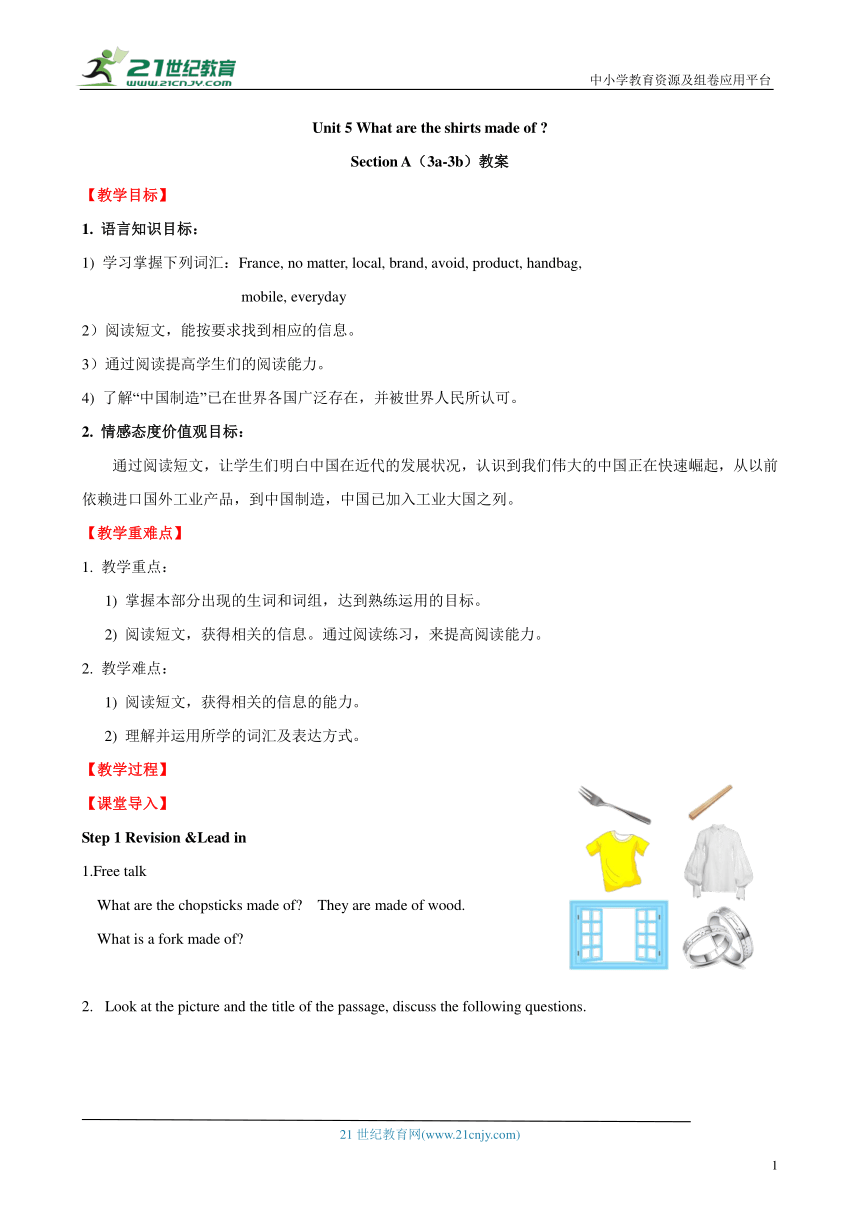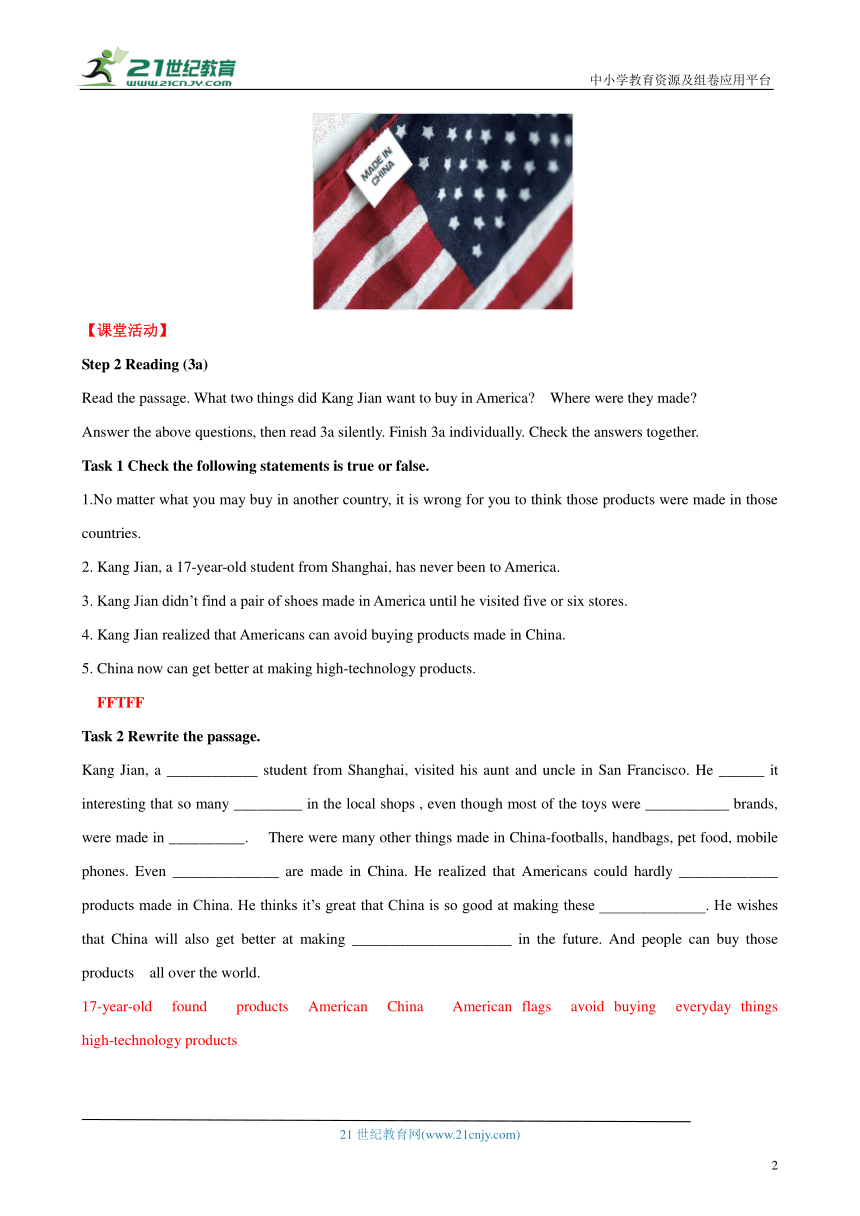Unit 5 What are the shirts made of? Section A (3a-3b) 教案
文档属性
| 名称 | Unit 5 What are the shirts made of? Section A (3a-3b) 教案 |  | |
| 格式 | doc | ||
| 文件大小 | 1.2MB | ||
| 资源类型 | 试卷 | ||
| 版本资源 | 人教新目标(Go for it)版 | ||
| 科目 | 英语 | ||
| 更新时间 | 2022-07-09 17:31:24 | ||
图片预览


文档简介
中小学教育资源及组卷应用平台
Unit 5 What are the shirts made of
Section A(3a-3b)教案
【教学目标】
1. 语言知识目标:
1) 学习掌握下列词汇:France, no matter, local, brand, avoid, product, handbag,
mobile, everyday
2)阅读短文,能按要求找到相应的信息。
3)通过阅读提高学生们的阅读能力。
4) 了解“中国制造”已在世界各国广泛存在,并被世界人民所认可。
2. 情感态度价值观目标:
通过阅读短文,让学生们明白中国在近代的发展状况,认识到我们伟大的中国正在快速崛起,从以前依赖进口国外工业产品,到中国制造,中国已加入工业大国之列。
【教学重难点】
1. 教学重点:
1) 掌握本部分出现的生词和词组,达到熟练运用的目标。
2) 阅读短文,获得相关的信息。通过阅读练习,来提高阅读能力。
2. 教学难点:
1) 阅读短文,获得相关的信息的能力。
2) 理解并运用所学的词汇及表达方式。
【教学过程】
【课堂导入】
Step 1 Revision &Lead in
1.Free talk
What are the chopsticks made of They are made of wood.
What is a fork made of
2. Look at the picture and the title of the passage, discuss the following questions.
【课堂活动】
Step 2 Reading (3a)
Read the passage. What two things did Kang Jian want to buy in America Where were they made
Answer the above questions, then read 3a silently. Finish 3a individually. Check the answers together.
Task 1 Check the following statements is true or false.
1.No matter what you may buy in another country, it is wrong for you to think those products were made in those countries.
2. Kang Jian, a 17-year-old student from Shanghai, has never been to America.
3. Kang Jian didn’t find a pair of shoes made in America until he visited five or six stores.
4. Kang Jian realized that Americans can avoid buying products made in China.
5. China now can get better at making high-technology products.
FFTFF
Task 2 Rewrite the passage.
Kang Jian, a ____________ student from Shanghai, visited his aunt and uncle in San Francisco. He ______ it interesting that so many _________ in the local shops , even though most of the toys were ___________ brands, were made in __________. There were many other things made in China-footballs, handbags, pet food, mobile phones. Even ______________ are made in China. He realized that Americans could hardly _____________ products made in China. He thinks it’s great that China is so good at making these ______________. He wishes that China will also get better at making _____________________ in the future. And people can buy those products all over the world.
17-year-old found products American China American flags avoid buying everyday things high-technology products
Step 3 Answer the questions (3b)
1.Make students understand the meaning of questions in 3b. Finish it and check the answers.
2.Ask and answer more questions according to the article in order to deepen the understanding of the essay.
Step 4 Exercise (3c)
Make students understand the meaning of questions in 3c. Finish it and check the answers.?
Step 5 Language points
1. no matter 无论;不论
no matter意为“无论”与“what, who, which, where, how”等疑问词连用,引导让步状语从句。
e.g. No matter what you say, I won’t believe you.
无论你说什么,我都不会相信你。
No matter when you are free, you can come here for a cup of tea.
无论你什么时候有空,都可以来这里喝杯茶。
2. local adj. 当地的;本地的
e.g. The local people are always friendly to tourists. 当地人对游客一向很热情。
3. avoid v. 避免;回避
avoid doing sth. 避免做某事
avoid 后面常跟名词、代词或动名词作宾语,但不能跟不定式作宾语。
e.g. They tried to avoid making Mrs. Li angry. 他们尽量避免让李老师生气。
Jack kept back his anger and avoided a fight.
杰克压住了怒火,避免了一场斗殴。
4. mobile adj. 可移动的;非固定的
mobile phone 手机
e.g. Would you please give us some details of your mobile phone
你能给我们一些你的手机的细节吗?
5. everyday adj. 每天的;日常的
everyday是every和day构成的合成词。everyday是形容词, 仅用在名词前作定语,不能单独使用。
e.g. everyday life日常生活everyday activities 日常活动
everyday与every day 辨析
every day是副词短语,意为“每天”,用作时间状语。
e.g. The teacher asked us to read English books every day.
老师让我们每天都要读英语。
【课堂小结】
Step 6 Summary
1.We have learnt how the passive voice is used in the article.
2.We have learnt how to use reading strategies to read a passage.
3.We have learnt some new words involving this article.
【课堂训练】
PPT
HYPERLINK "http://21世纪教育网(www.21cnjy.com)
" 21世纪教育网(www.21cnjy.com)
Unit 5 What are the shirts made of
Section A(3a-3b)教案
【教学目标】
1. 语言知识目标:
1) 学习掌握下列词汇:France, no matter, local, brand, avoid, product, handbag,
mobile, everyday
2)阅读短文,能按要求找到相应的信息。
3)通过阅读提高学生们的阅读能力。
4) 了解“中国制造”已在世界各国广泛存在,并被世界人民所认可。
2. 情感态度价值观目标:
通过阅读短文,让学生们明白中国在近代的发展状况,认识到我们伟大的中国正在快速崛起,从以前依赖进口国外工业产品,到中国制造,中国已加入工业大国之列。
【教学重难点】
1. 教学重点:
1) 掌握本部分出现的生词和词组,达到熟练运用的目标。
2) 阅读短文,获得相关的信息。通过阅读练习,来提高阅读能力。
2. 教学难点:
1) 阅读短文,获得相关的信息的能力。
2) 理解并运用所学的词汇及表达方式。
【教学过程】
【课堂导入】
Step 1 Revision &Lead in
1.Free talk
What are the chopsticks made of They are made of wood.
What is a fork made of
2. Look at the picture and the title of the passage, discuss the following questions.
【课堂活动】
Step 2 Reading (3a)
Read the passage. What two things did Kang Jian want to buy in America Where were they made
Answer the above questions, then read 3a silently. Finish 3a individually. Check the answers together.
Task 1 Check the following statements is true or false.
1.No matter what you may buy in another country, it is wrong for you to think those products were made in those countries.
2. Kang Jian, a 17-year-old student from Shanghai, has never been to America.
3. Kang Jian didn’t find a pair of shoes made in America until he visited five or six stores.
4. Kang Jian realized that Americans can avoid buying products made in China.
5. China now can get better at making high-technology products.
FFTFF
Task 2 Rewrite the passage.
Kang Jian, a ____________ student from Shanghai, visited his aunt and uncle in San Francisco. He ______ it interesting that so many _________ in the local shops , even though most of the toys were ___________ brands, were made in __________. There were many other things made in China-footballs, handbags, pet food, mobile phones. Even ______________ are made in China. He realized that Americans could hardly _____________ products made in China. He thinks it’s great that China is so good at making these ______________. He wishes that China will also get better at making _____________________ in the future. And people can buy those products all over the world.
17-year-old found products American China American flags avoid buying everyday things high-technology products
Step 3 Answer the questions (3b)
1.Make students understand the meaning of questions in 3b. Finish it and check the answers.
2.Ask and answer more questions according to the article in order to deepen the understanding of the essay.
Step 4 Exercise (3c)
Make students understand the meaning of questions in 3c. Finish it and check the answers.?
Step 5 Language points
1. no matter 无论;不论
no matter意为“无论”与“what, who, which, where, how”等疑问词连用,引导让步状语从句。
e.g. No matter what you say, I won’t believe you.
无论你说什么,我都不会相信你。
No matter when you are free, you can come here for a cup of tea.
无论你什么时候有空,都可以来这里喝杯茶。
2. local adj. 当地的;本地的
e.g. The local people are always friendly to tourists. 当地人对游客一向很热情。
3. avoid v. 避免;回避
avoid doing sth. 避免做某事
avoid 后面常跟名词、代词或动名词作宾语,但不能跟不定式作宾语。
e.g. They tried to avoid making Mrs. Li angry. 他们尽量避免让李老师生气。
Jack kept back his anger and avoided a fight.
杰克压住了怒火,避免了一场斗殴。
4. mobile adj. 可移动的;非固定的
mobile phone 手机
e.g. Would you please give us some details of your mobile phone
你能给我们一些你的手机的细节吗?
5. everyday adj. 每天的;日常的
everyday是every和day构成的合成词。everyday是形容词, 仅用在名词前作定语,不能单独使用。
e.g. everyday life日常生活everyday activities 日常活动
everyday与every day 辨析
every day是副词短语,意为“每天”,用作时间状语。
e.g. The teacher asked us to read English books every day.
老师让我们每天都要读英语。
【课堂小结】
Step 6 Summary
1.We have learnt how the passive voice is used in the article.
2.We have learnt how to use reading strategies to read a passage.
3.We have learnt some new words involving this article.
【课堂训练】
PPT
HYPERLINK "http://21世纪教育网(www.21cnjy.com)
" 21世纪教育网(www.21cnjy.com)
同课章节目录
- Unit 1 How can we become good learners.
- Section A
- Section B
- Unit 2 I think that mooncakes are delicious!
- Section A
- Section B
- Unit 3 Could you please tell me where the restroom
- Section A
- Section B
- Unit 4 I used to be afraid of the dark.
- Section A
- Section B
- Unit 5 What are the shirts made of?
- Section A
- Section B
- Review of Units 1-5
- Unit 6 When was it invented?
- Section A
- Section B
- Unit 7 Teenagers should be allowed to choose their
- Section A
- Section B
- Unit 8 It must belong to Carla.
- Section A
- Section B
- Unit 9 I like music that I can dance to.
- Section A
- Section B
- Unit 10 You're supposed to shake hands.
- Section A
- Section B
- Review of Units 6-10
- Unit 11 Sad movies make me cry.
- Section A
- Section B
- Unit 12 Life is full of the unexpected
- Section A
- Section B
- Unit 13 We're trying to save the earth!
- Section A
- Section B
- Unit 14 I remember meeting all of you in Grade 7.
- Section A
- Section B
- Review of Units 11-14
